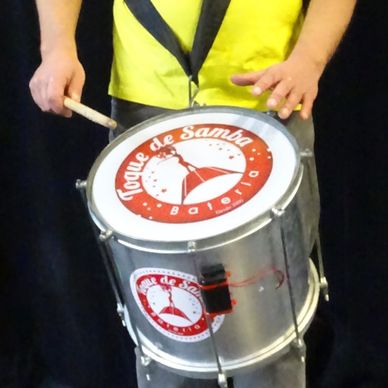Learn the samba instruments - Musicality of Samba
Surdos
Repique or Repinique
Repique or Repinique
Surdos (the big drums) are the pulsation (or TEMPO) of the bateria, the strongest part of the music, it’s the reference for all the other instruments.. They give the “andamento” ( the rhythm) or TEMPO of which the bateria will play (faster or slower).
There are 3 Surdos: surdo de primeira (first - the biggest drum), surdo de segunda (second - smaller than the first drum) and surdo de Terceira (third - the smallest one).
The counting on a bateria goes 1, 2, 3, 4 (4 counts then starts again).
The surdo de primeira hits the second and fourth counts, and the surdo de segunda hits the first and third counts. Usually, the sound of the Surdo de primeira is bass, the segunda mid and the terceira is treble (the bateria da Mocidade has the other way around, primeira is treble and the second one is bass - it depends on the bateria style). Mangueira bateria has only the surdo de primeira (no second or third).
The Surdo de Terceira, the third one, usually the smallest of the three, will give the balance between the other two - THE CONTRA (QUICK).
Repique or Repinique
Repique or Repinique
Repique or Repinique

Repique or Repinique is a smaller drum than the Surdos played by one hand and one drum stick. Its sound is similar to the 'caixa' but deeper, stronger.
It's the loudest instrument in a Bateria.
The Repique is the Bateria 'conductor', guiding the rhythm of the melody. It can be also considered as a forth surdo since it maintains the rhythm, the TEMPO of the Bateria.
The Repique normally introduces the Bateria (the drums), it's the instrument that starts the song.
It can be also played solo in mid-songs or together with the tamborins.
"Repique de mão", is a smaller version of the normal Repique, commonly used in "Samba de Roda".
Tamborim
Repique or Repinique
Tamborim

The most popular instrument due to its small size, the Tamborim fits in one hand and it's played using a single or triple rounded beater.
Don't be fool by its size, it's one of the most difficult to learn instruments of a Bateria.
The Tamborim has a highlight position inside a Bateria. You can guide your dance steps by listening to it.
We say the Tamborim 'make lines, draw' the samba melody and accentuate it, making more exciting.
The most common 'levada' or melody played in a Tamborim is the 'carreteiro' (in 4 counts).
Caixa
Chocalho
Tamborim

Also known as tarola, tarol, caixeta clara, or snare drum. It's the instrument that gives the identity to each one of the Baterias of a Escola de Samba (Schools of Samba), meaning that each school of samba has its own style of playing the Caixa.
Caixa is commonly used in military bands, giving the pace, the rhythm of a military march.
Caixa is played by two drum sticks and it's normally hold on one arm/ shoulder, or by a harness.
Chocalho
Chocalho
Chocalho

Normally made of wood and metal discs, the Chocalho is an instrument that 'jingles' giving a distinguishable sound that resonates through the Bateria. It emphasises the bass more than the high tones.
The Chocalho together with the Caixa gives the melody of samba.
It's played by both hands and the player needs strong arms and endurance to play this instrument.
Cuica
Chocalho
Chocalho

The Cuíca is a small drum with a wooden stick internally attached to the skin that covers the head of the Cuíca.
The sound is made by friction of this wooden stick using a piece of wet cloth. The sound is very characteristic and it's similar to a snorting sound.
Agogô
Pandeiro
Agogô

Agogô is a single or a multiple bells with origins in traditional Yoruba music.
The agogô may be the oldest samba instrument and was based on West African Yoruba single or double bells.
The agogô has the highest pitch of any of the bateria instruments.
Tantã
Pandeiro
Agogô

Tantã or Tan-tan is a cylindrical hand drum that is used in small samba groups and pagode ensembles. It imitates the big Surdo (primeira). However, due to its smaller size, the Tantã is not as loud as a Surdo and so it is played rarely in big samba schools, but rather within closer gatherings of musicians called "Rodas de Samba".
The Tantã is a type of drum played in a sitting or standing position by one hand beating the drum head whilst the other hand taps the metal or wood body of the drum.
Pandeiro
Pandeiro
Pandeiro

The pandeiro is a hand frame drum very popular in Brazil.
The drumhead is tunable, and the rim holds metal jingles (platinelas), which are cupped creating a crisper, drier tone. It is held in one hand, and struck on the head by the other hand to produce the sound. Typical pandeiro patterns are played by alternating the thumb, fingertips, heel, and palm of the hand. A Pandeiro can also be shaken to make sound, similar to the chocalho, or one can run a finger along the head to produce a roll.
The Pandeiro is used in a different Brazilian types of music such as samba, coco, chore and capoeira.
Samba de Rainha
Cookie Policy
This website uses cookies. By continuing to use this site, you accept our use of cookies. Privacy Policy
